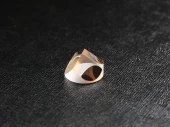Description
Corner Cube Retro-Reflectors from Rocky Mountain Instrument Co. are precision optical components designed to reflect light back to its source. Utilizing the principle of total internal reflection (TIR), these retro-reflectors ensure that a beam entering the aperture is reflected by the three roof surfaces and exits parallel to the incoming beam. This unique property is maintained regardless of the orientation of the retro-reflector, provided it remains within its acceptance angle limitations.
In scenarios where the acceptance angle for TIR is exceeded or when maintaining clean reflecting surfaces is challenging, a metal or dielectric coating can be applied to the surfaces to enhance performance. This adaptability makes Corner Cube Retro-Reflectors a versatile choice for various optical applications, ensuring consistent and reliable performance.
Rocky Mountain Instrument Co. prides itself on a collaborative approach, working closely with clients from the early stages of development to deliver efficient and manufacturable solutions. This commitment to customer satisfaction and technical excellence positions RMI as a leader in the optical components industry.
RMI Corner Cube Retro-Reflectors
Specifications
| Type And Material: | BK7, FS, UVFS |
|---|---|
| Mounting: | Unmounted |
| Dimensions: | Custom |
| Surface Figure: | Lambda/20 @ 633nm |
| Surface Quality: | 10-5 Scratch-Dig |
Features
- Total Internal Reflection (TIR): Corner Cube Retro-Reflectors utilize TIR to ensure that a beam entering the effective aperture is reflected by the three roof surfaces and exits parallel to itself.
- Orientation Independence: The performance is independent of the retro-reflector's orientation within acceptance angle limitations.
- Coating Options: For applications where the acceptance angle for TIR is exceeded or surfaces need extra cleanliness, metal or dielectric coatings can be applied.
- Material Options: Available in BK7, UVFS, FS, and CaF2.
- Dimensional Tolerance: +0.000", –0.010"
- Angular Deviation: 180º
- Bevels: Minimum safety bevel on all edges; apex unbeveled
- Clear Aperture: Exceeds central 85% of diameter
Applications
- Laser Ranging Systems: Utilize the precise reflection properties of corner cube retro-reflectors for accurate distance measurements.
- Surveying Equipment: Enhance the accuracy of land surveying instruments with reliable retro-reflection capabilities.
- Optical Alignment: Use in alignment systems to ensure parallel beam exit for precise optical alignment.
- Targeting Systems: Implement in targeting and guidance systems for consistent and reliable beam return.
- Metrology: Apply in metrology tools for precise measurement and calibration tasks.
- Space Applications: Suitable for satellite and space exploration equipment requiring robust and reliable reflection.
- Robotics: Utilize in robotic vision systems to improve accuracy and performance.
- Laser Interferometry: Enhance the performance of interferometers by maintaining beam coherence and alignment.
Frequently Asked Questions
How does a Corner Cube Retro-Reflector work?
What is a Corner Cube Retro-Reflector?
What is the surface figure of a Corner Cube Retro-Reflector?
What materials are used to make a Corner Cube Retro-Reflector?
What is the dimensional tolerance of a Corner Cube Retro-Reflector?
Similar Products









Your inquiry has been received.
Create an account by adding a password
Why create an account?
- Auto-complete inquiry forms
- View and manage all your past messages
- Save products to your favorites
- Close your account anytime — no hassle
